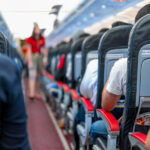In the ever-evolving world of air travel, one aspect remains constant: the quest for the perfect airplane seat. As travelers become increasingly savvy, the choice of where to sit during a flight can significantly impact the overall journey experience. Whether you’re a frequent flyer or an occasional vacationer, understanding the nuances of airplane seating can transform your trip from merely tolerable to genuinely enjoyable. Let’s explore the factors that contribute to finding your ideal spot in the sky.
The Window vs. Aisle Debate

One of the most fundamental choices in airplane seating is between window and aisle seats. Each option comes with its own set of advantages:
Window Seat Benefits:
- Unparalleled views during takeoff, landing, and flight
- Control over the window shade
- A wall to lean against for sleeping
- No disturbances from fellow passengers needing to access the aisle
Aisle Seat Advantages:
- Easy access to overhead bins and lavatories
- Ability to stretch legs into the aisle (when safe)
- Quicker exit upon arrival
The middle seat, often considered the least desirable, offers neither the view of a window seat nor the accessibility of an aisle seat. However, for those traveling in pairs, booking the window and aisle seats in a row of three might result in an empty middle seat if the flight isn’t full.
Timing is Everything
Securing your preferred seat often comes down to timing. Many airlines allow seat selection during booking, though this may incur an additional fee. For budget-conscious travelers, it’s worth noting that some carriers offer free seat selection 24 hours before departure when online check-in opens. Setting a reminder for this window can significantly increase your chances of snagging a desirable spot.
Understanding Aircraft Layouts

Familiarizing yourself with typical airplane configurations can give you an edge in seat selection. Most commercial aircraft feature a 3-3 layout in economy class, with three seats on either side of a single aisle. Smaller planes may have a 2-2 layout, while larger aircraft often boast a 3-4-3 configuration for long-haul flights.
Seats are typically labeled with letters, starting from the left side of the plane (facing forward) with A, B, C, then skipping a letter for the aisle, and continuing with D, E, F on the right side. In wider planes, you might encounter configurations like A, B, C – D, E, F, G – H, J, K.
The Allure of Extra Legroom

For taller passengers or those simply craving more space, certain seats offer additional legroom:
- Exit Row Seats:
- Significantly more legroom
- Often recline further than standard seats
- Quicker disembarkation upon arrival
- May come with an extra charge
- Cannot be occupied by children, elderly, or those with mobility issues
- Armrests are usually immovable due to tray tables being stored inside
- Bulkhead Seats:
- Located immediately behind physical partitions
- No one reclining into your space
- Often offer more legroom
- Ideal for travelers with babies due to bassinets attachments
- Limited under-seat storage
- Tray tables and entertainment screens are often stored in the armrests
- Aisle Seats:
- Allow for leg stretching into the aisle when safe
Considerations for Nervous Flyers
If you experience flight anxiety, your seat choice can make a difference:
- Opt for seats between the wings or at the front of the plane, where turbulence is less noticeable
- Choose an aisle seat for easy access to move about or speak with flight attendants
- Avoid seats near lavatories or galleys, which can be noisier and more crowded
Long-Haul Flight Strategies
For extended journeys, consider these additional tips:
- Avoid seats near lavatories and galleys to minimize noise and odors
- On overnight flights, seats closer to the front of the economy cabin are often quieter
- If traveling as a couple, consider booking a window and aisle seat in a row of three for potential extra space
The Role of Airline Status and Fare Class
Frequent flyers with elite status often enjoy complimentary access to preferred seating. Additionally, booking higher fare classes can unlock better seat selection options. It’s worth considering these factors when planning your travel, especially for longer flights where comfort is paramount.
Leveraging Technology
Several online tools can aid in your seat selection process:
- SeatGuru: Provides detailed seat maps for specific flights, highlighting both desirable and potentially problematic seats
- Airline websites and apps: Often offer seat maps and selection options
- Third-party booking sites: Some provide seat selection tools during the booking process
Last-Minute Opportunities
Even if you’re initially stuck with a less-than-ideal seat, all hope is not lost:
- Keep checking the airline’s website or app for last-minute openings
- Politely inquire at the check-in counter or gate about better seat options
- Be prepared to explain any specific needs or concerns that might warrant a seat change
The Price of Comfort
While many airlines now charge for seat selection, especially for more desirable spots, it’s worth considering the value of comfort on longer flights. Paying a bit extra for a well-chosen seat can significantly enhance your travel experience.
Flying with Children

Family travel presents unique seating challenges:
- Book well in advance to ensure your family can sit together
- Consider the bulkhead for infant bassinets on long flights
- Be strategic with seat assignments to maximize comfort for both children and adults
Considering Air Quality
While there are many myths about air quality on planes, modern aircraft circulation systems generally provide even air distribution throughout the cabin. However, seats near lavatories might experience less pleasant odors, so factor this into your decision if you’re sensitive to smells.
The Middle Seat Dilemma
While generally considered the least desirable option, middle seats can sometimes be strategically advantageous:
- In a group of three, it allows for easier conversation
- Some airlines offer slightly wider middle seats as a comfort measure
- If traveling solo, choosing a middle seat between two occupied seats might increase your chances of being moved to a better spot if the flight isn’t full
Conclusion: The Personal Nature of Seat Selection
Ultimately, the “best” airplane seat varies from traveler to traveler. What works for a solo business traveler might not be ideal for a family with young children. By understanding aircraft layouts, considering your personal preferences, and utilizing available tools and strategies, you can significantly increase your chances of a comfortable flight.
Remember, flexibility can be key. While having a preferred seat in mind is important, being open to last-minute changes or unexpected opportunities can sometimes lead to pleasant surprises. Whether you prioritize legroom, minimal disturbances, or quick exit upon landing, armed with this knowledge, you’re now equipped to make informed decisions about your seating arrangements.
As air travel continues to evolve, staying informed about airline policies and aircraft configurations will help you navigate the complexities of seat selection. With these tips in mind, you can transform what was once a dreaded aspect of flying into an opportunity to enhance your travel experience, making your journey through the skies as comfortable and enjoyable as possible.




